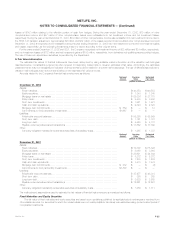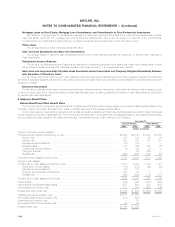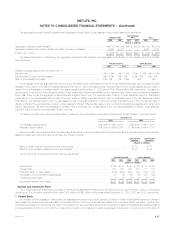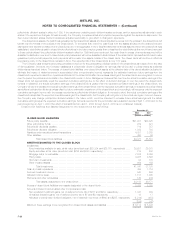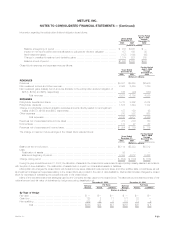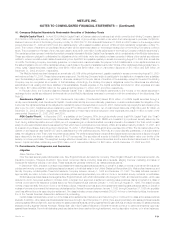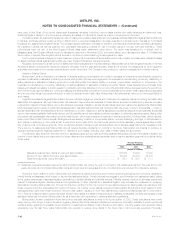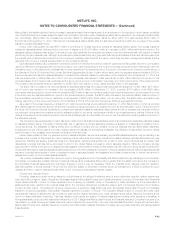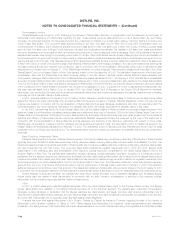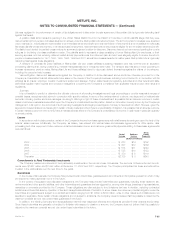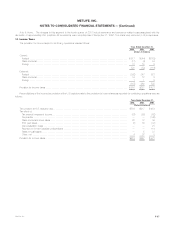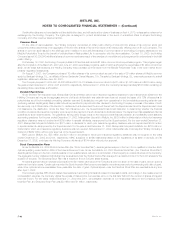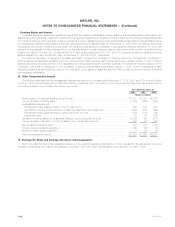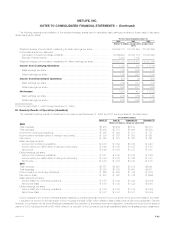MetLife 2002 Annual Report Download - page 77
Download and view the complete annual report
Please find page 77 of the 2002 MetLife annual report below. You can navigate through the pages in the report by either clicking on the pages listed below, or by using the keyword search tool below to find specific information within the annual report.METLIFE, INC.
NOTES TO CONSOLIDATED FINANCIAL STATEMENTS — (Continued)
Metropolitan Life’s liability reflected that the increase in asbestos-related claims was a result of an acceleration in the reporting of such claims; the liability
now reflects that such an increase is also the result of an increase in the total number of asbestos-related claims expected to be received by Metropolitan
Life. Accordingly, Metropolitan Life increased its recorded liability for asbestos-related claims by $402 million from approximately $820 million to
$1,225 million at December 31, 2002. This total recorded asbestos-related liability (after the self-insured retention) is within the coverage of the excess
insurance policies discussed below.
During 1998, Metropolitan Life paid $878 million in premiums for excess insurance policies for asbestos-related claims. The excess insurance
policies for asbestos-related claims provide for recovery of losses up to $1,500 million, which is in excess of a $400 million self-insured retention. The
asbestos-related policies are also subject to annual and per-claim sublimits. Amounts are recoverable under the policies annually with respect to claims
paid during the prior calendar year. Although amounts paid by Metropolitan Life in any given year that may be recoverable in the next calendar year under
the policies will be reflected as a reduction in the Company’s operating cash flows for the year in which they are paid, management believes that the
payments will not have a material adverse effect on the Company’s liquidity.
Each asbestos-related policy contains an experience fund and a reference fund that provides for payments to Metropolitan Life at the commutation
date if the reference fund is greater than zero at commutation or pro rata reductions from time to time in the loss reimbursements to Metropolitan Life if the
cumulative return on the reference fund is less than the return specified in the experience fund. The return in the reference fund is tied to performance of
the Standard & Poor’s 500 Index and the Lehman Brothers Aggregate Bond Index. A claim will be made under the excess insurance policies in 2003 for
the amounts paid with respect to asbestos litigation in excess of the retention. Based on performance of the reference fund, at December 31, 2002, the
loss reimbursements to Metropolitan Life in 2003 and the recoverable with respect to later periods will be $42 million less than the amount of the
recorded losses. Such foregone loss reimbursements may be recovered upon commutation depending upon future performance of the reference fund.
The foregone loss reimbursements are estimated to be $9 million with respect to 2002 claims and $42 million in the aggregate.
The $402 million increase in the recorded liability for asbestos claims less the foregone loss reimbursement adjustment of $42 million ($27 million,
net of income tax) resulted in an increase in the recoverable of $360 million. At December 31, 2002, a portion ($136 million) of the $360 million
recoverable was recognized in income while the remainder ($224 million) was recorded as a deferred gain which is expected to be recognized in income
in the future over the estimated settlement period of the excess insurance policies. The $402 million increase in the recorded liability, less the portion of
the recoverable recognized in income, resulted in a net expense of $266 million ($169 million, net of income tax). The $360 million recoverable may
change depending on the future performance of the Standard & Poor’s 500 Index and the Lehman Brothers Aggregate Bond Index.
As a result of the excess insurance policies, $1,237 million is recorded as a recoverable at December 31, 2002 ($224 million of which is recorded
as a deferred gain as mentioned above); the amount includes recoveries expected to be obtained in 2003 for amounts paid in 2002. If at some point in
the future, the Company believes the liability for probable and estimable losses for asbestos-related claims should be increased, an expense would be
recorded and the insurance recoverable would be adjusted subject to the terms, conditions and limits of the excess insurance policies. Portions of the
change in the insurance recoverable would be recorded as a deferred gain and amortized into income over the estimated remaining settlement period of
the insurance policies.
The Company believes adequate provision has been made in its consolidated financial statements for all probable and reasonably estimable losses
for asbestos-related claims. The ability of Metropolitan Life to estimate its ultimate asbestos exposure is subject to considerable uncertainty due to
numerous factors. The availability of data is limited and it is difficult to predict with any certainty numerous variables that can affect liability estimates,
including the number of future claims, the cost to resolve claims, the disease mix and severity of disease, the jurisdiction of claims filed, tort reform efforts
and the impact of any possible future adverse verdicts and their amounts.
Recent bankruptcies of other companies involved in asbestos litigation, as well as advertising by plaintiffs’ asbestos lawyers, may be resulting in an
increase in the number of claims and the cost of resolving claims, as well as the number of trials and possible adverse verdicts Metropolitan Life may
experience. Plaintiffs are seeking additional funds from defendants, including Metropolitan Life, in light of such recent bankruptcies by certain other
defendants. It is likely that bills will be introduced in 2003 in the United States Congress to reform asbestos litigation. While the Company strongly
supports reform efforts, there can be no assurance that legislative reforms will be enacted. Metropolitan Life will continue to study its claims experience,
review external literature regarding asbestos claims experience in the United States and consider numerous variables that can affect its asbestos liability
exposure, including bankruptcies of other companies involved in asbestos litigation and legislative and judicial developments, to identify trends and to
assess their impact on the recorded asbestos liability.
The number of asbestos cases that may be brought or the aggregate amount of any liability that Metropolitan Life may ultimately incur is uncertain.
Accordingly, it is reasonably possible that the Company’s total exposure to asbestos claims may be greater than the liability recorded by the Company in
its consolidated financial statements and that future charges to income may be necessary. While the potential future charges could be material in
particular quarterly or annual periods in which they are recorded, based on information currently known by management, it does not believe any such
charges are likely to have a material adverse effect on the Company’s consolidated financial position.
Property and Casualty Actions
Purported class action suits involving claims by policyholders for the alleged diminished value of automobiles after accident-related repairs have
been filed in Rhode Island, Texas, Georgia and Tennessee against Metropolitan Property and Casualty Insurance Company. Rhode Island and Texas trial
courts denied plaintiffs’ motions for class certification and a hearing on plaintiffs’ motion in Tennessee for class certification is to be scheduled. A
settlement has been reached in the Georgia class action; the Company determined to settle the case in light of a Georgia Supreme Court decision
involving another insurer. The settlement is being implemented. A purported class action has been filed against Metropolitan Property and Casualty
Insurance Company’s subsidiary, Metropolitan Casualty Insurance Company, in Florida. The complaint alleges breach of contract and unfair trade
practices with respect to allowing the use of parts not made by the original manufacturer to repair damaged automobiles. Discovery is ongoing and a
motion for class certification is pending. Total loss valuation methods are the subject of national class actions involving other insurance companies. A
Pennsylvania state court purported class action lawsuit filed in 2001 alleges that Metropolitan Property and Casualty Insurance Company improperly took
depreciation on partial homeowner losses where the insured replaced the covered item. The court has dismissed the action. An appeal has been filed.
Metropolitan Property and Casualty Insurance Company and Metropolitan Casualty Insurance Company are vigorously defending themselves against
these lawsuits.
MetLife, Inc. F-33




